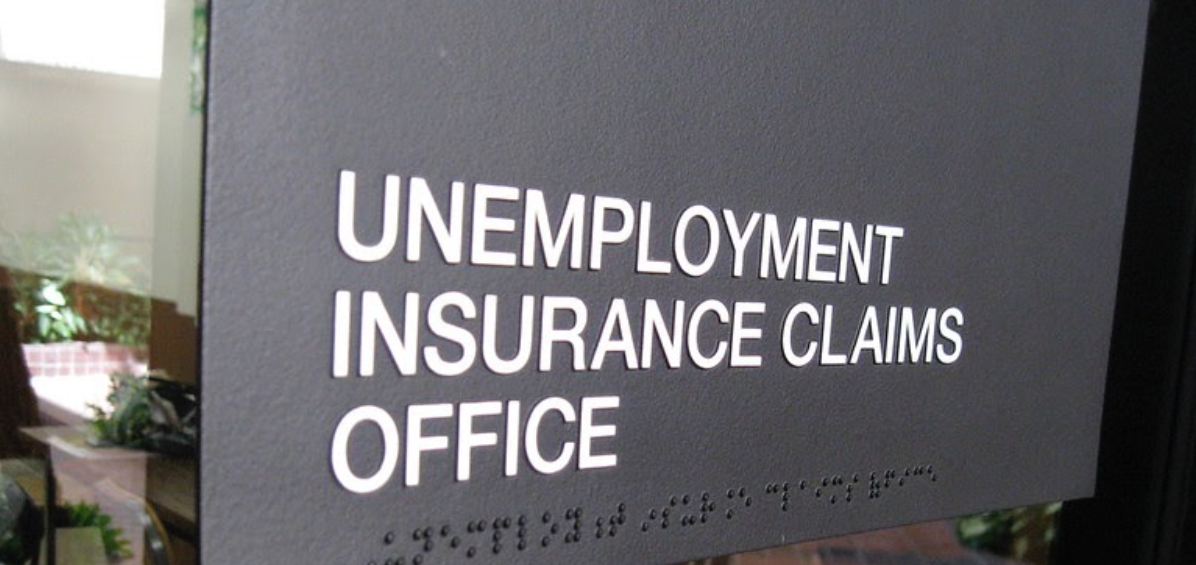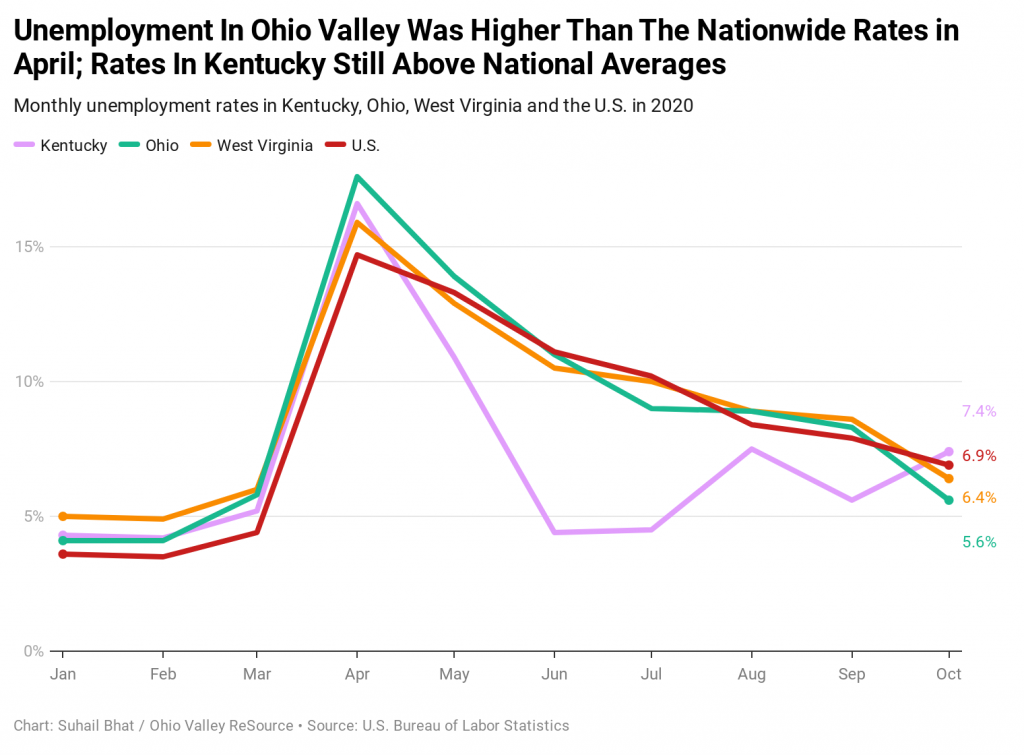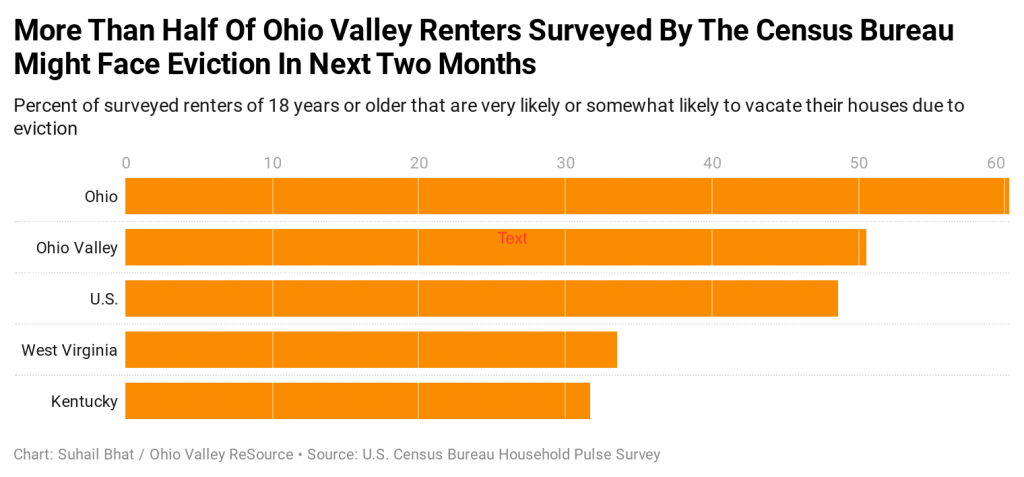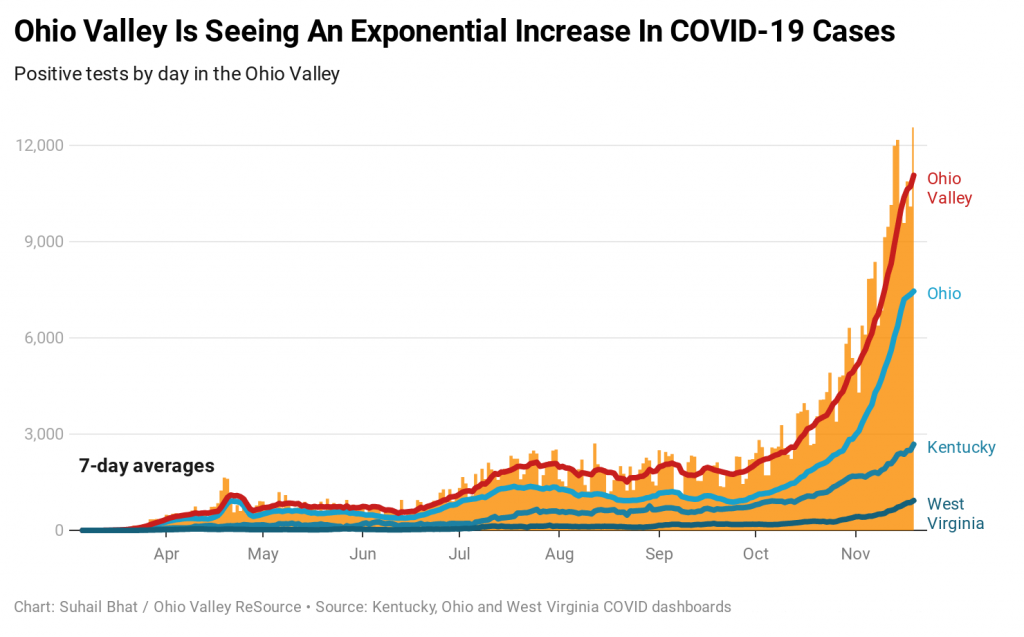News

Ohio Valley Economic Outlook Grim As COVID Aid Programs End
< < Back to ohio-valley-economic-outlook-grim-as-covid-aid-programs-endWHITESBURG, Ky. (OVR) — With hundreds of thousands across the Ohio Valley struggling to make ends meet, a suite of coronavirus aid packages, including rent and utility relief funding, eviction moratoriums, and expanded unemployment benefits, is set to expire at the end of December.
The consequences could be far-reaching. Poverty rates have soared as some federal programs, including the additional $600 in weekly unemployment aid, came to a close. Now, over 75% of Kentucky’s 7,654 independent restaurants are in danger of closing permanently, according to the Independent Restaurant Coalition; one in three West Virginians is at risk of eviction; 16% of Ohioans are behind on their rent. According to the Bureau of Labor Statistics, the national unemployment rate is 6.9% — well below the terrifying peaks of late spring, but twice what it was in February.
Even those who do have cash to spend are being more cautious with it.
“People just are still uncomfortable, and rightly so,” said Sean O’Leary, a senior policy analyst with the West Virginia Center on Budget and Policy, a left-leaning think tank. “They don’t want to take unnecessary risks. They’re not going out, they’re not spending the money that they normally would be.”
Federal legislators from Kentucky’s powerful senior senator, Majority Leader Mitch McConnell, to Democratic Speaker of the House Nancy Pelosi agree they want to pass more aid, but despite multiple rounds of negotiations, the parties remain divided on major ticket items.
While Washington haggles over the price tag for more aid, people across the Ohio Valley prepare for a difficult winter as soaring coronavirus cases force more restrictions on workers and businesses.
Eviction Emergency
About half of renters surveyed by the Census Bureau reported being “very likely” or “somewhat likely” to leave their home due to eviction in the coming months, according to Household Pulse data from the U.S. Census Bureau.
Housing experts have expressed concern for months about a “tsunami” of evictions, including Homeless and Housing Coalition of Kentucky executive director Adrienne Bush. In a call with reporters in July, Bush said evictions don’t happen all at once: Families often spend down their savings, take out more debt, or ask relatives for some help before they resort to homeless shelters.
That’s the situation landlord Mark Kidd, who owns seven rental units in Letcher County, Kentucky sees for several of his tenants. Kidd is disabled, and his rental properties account for most of his monthly income. The units rent for anywhere from $400 to $700 per month.
“Up until maybe May, there wasn’t too much of a hit to my finances from this, but it’s become quite a pressing issue over the intervening time,” he said.
Kidd’s tenants have suffered financial hardship during the coronavirus, so Kidd has worked with them to establish payment plans, or take over their utility bills. He’s spent down what he had in reserve, and he worries whether he’ll have enough to pay a handyman if there were to be a plumbing emergency.
One tenant was laid off in March due to the pandemic. The tenant applied for unemployment, but never received it. When Kidd heard that Kentucky Gov. Andy Beshear was establishing a fund to help renters meet their payments, he encouraged the tenant to apply.
Kentucky’s Healthy at Home Eviction Relief Fund, which was established August 24 with $15 million in CARES Act funding, closed to new applications on November 5. According to the website, “We have not expended all funds, but do expect to use all available funding on applications already received.”
Kidd’s tenant has not yet received aid from the fund; the application has been categorized as “File Review Complete” for about a month.
“I’ve never evicted a tenant … uh, ever,” Kidd said. “And I’m not promising I never will, but I really… that would be one of the apocalyptic scenarios. But I guess this is sort of an apocalyptic world.”
Ohio Gov. Mike DeWine dedicated $50 million to a combined rent- and utility-relief fund; in West Virginia, Gov. Jim Justice did not establish a fund specifically for rental assistance.
Any CARES Act money left unspent on December 31 must be returned to the federal government.
Utilities Support
On September 21, the Kentucky Public Service Commission said it estimated Kentuckians would miss a total of $150 million in water, sewer, gas and electric bills by the end of 2020.
Gov. Beshear on October 19 announced the $15 million Healthy at Home Utility Relief Fund to help cover those bills. Customers will also need support in 2021 but the program expires at the end of this year.
In West Virginia, the Public Service Commission sent out 133,000 letters to customers who were delinquent on utility bills, urging them to apply for that state’s $25 million utility relief fund.
“We have a total of about 26 what we call ‘larger utilities’” — most of them electric services, said PSC chairman Charlotte Lane. “We also have about 600 public service districts, water association, municipalities, and all of those are in the smaller category.”
Lane’s office is still crunching the numbers on those smaller water districts, she said, but so far, 40,000 customers of the 26 larger utility companies — about 39% of eligible households — returned applications requesting a total of $14 million in aid. If all eligible households had applied, Lane said, there would have been $30 million requested for only customers of the larger utilities for only accounts that were delinquent between March 1 and July 31.
“If Congress decides to provide more relief for utilities because of the number of people that haven’t been able to pay their bills, we could certainly welcome that,” Lane said.
States have established a patchwork of orders prohibiting utility shut offs during the pandemic. Ohio and West Virginia do not currently have shutoff moratoriums; Kentucky’s ends December 31.
Unemployment & Student Loans
Pandemic Unemployment Assistance, which extended unemployment benefits to gig workers and the self-employed, is set to expire December 26. In Kentucky, according to the Department of Labor, some 50,201 workers stand to lose coverage; in West Virginia, 51,885; and in Ohio, 431,405 people will become ineligible for unemployment when the program expires.
Also expiring the day after Christmas is the Pandemic Emergency Unemployment Compensation, which provided an additional 13 weeks of benefits after workers had used the weeks of unemployment regularly covered by their state.
Most states, including Kentucky, Ohio and West Virginia, normally provide 26 weeks of unemployment insurance; PEUC extended that to 39 weeks.
“What we’re seeing is, people who were already out of work when the pandemic started, they’re really starting to run out of those weeks, even with the PEUC,” said Jessica Klein, a policy analyst at the Kentucky Center for Economic Policy, a left-leaning think tank.
As expanded unemployment benefits expire amid high unemployment and a lethargic economic recovery, the Department of Education’s suspension of student loan payments is also set to expire.
About 217,000 West Virginians, 575,000 Kentuckians, and 1.7 million Ohioans will have to resume payments on their student loans beginning in January.
As case counts rise, elected leaders must weigh the scales: allow businesses to remain open and risk overflowing hospitals, or tighten up on the economy and risk widespread hardship.
All three Ohio Valley states have seen record-high numbers of cases in the current wave of the virus, reporting a combined 12,558 positive tests on Thursday. Hospitalizations and deaths have soared over the past weeks, forcing governors to announce stricter guidance as the holiday season — which is expected to contribute to the ongoing surge — nears.
The Ohio Valley ReSource is supported by the Corporation for Public Broadcasting and our partner stations.




